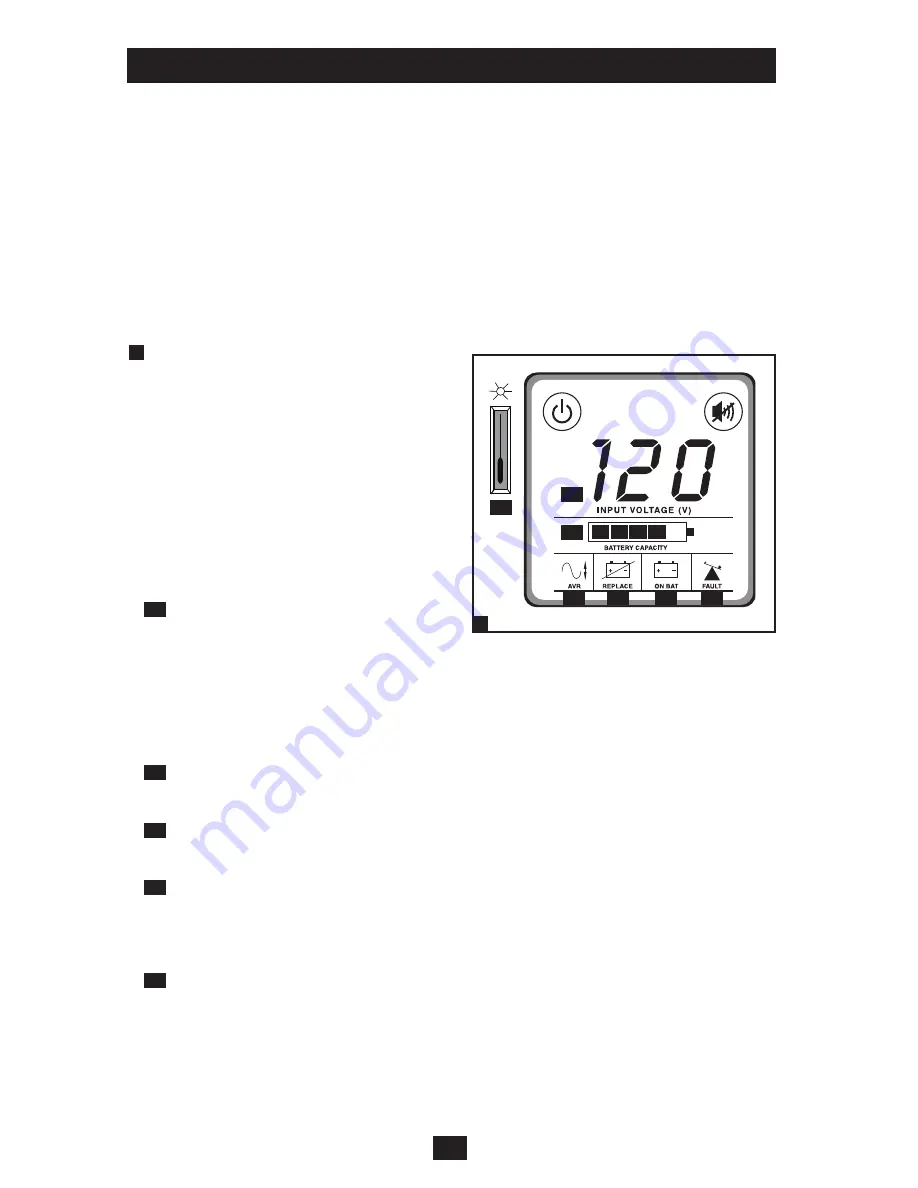
4
Basic Operation (Front Panel)
continued
• If the “FAULT” icon remains lit and the alarm continues to sound after the test, the battery-
supported outlets are overloaded. To clear the overload, unplug some of your equipment from the
battery-supported outlets and repeat the self-test until the “FAULT” icon is no longer lit and the
alarm is no longer sounding.
Note:
The alarm beeps once per minute.
CAUTION! Any overload that is not corrected by the user immediately following a self-test
may cause the UPS to shut down and cease supplying output power in the event of a blackout
or brownout.
• If the “REPLACE” icon remains lit and the alarm continues to sound after the test, the UPS
batteries need to be recharged or replaced. Allow the UPS to recharge continuously for 24 hours,
and repeat the self-test. If the icon continues to illuminate after repeated self tests, contact
Tripp Lite for service. Battery replacement should only be performed by qualified service
personnel. If the UPS requires battery replacement, Tripp Lite offers a complete line of replacement
batteries at www.tripplite.com.
Note:
The alarm beeps once per minute.
3
LCD Status Screen
The LCD Status Screen indicates a variety of
UPS operational conditions. All descriptions
apply when the UPS is plugged into an AC outlet
and turned on.
Note: The LCD will illuminate for 1 second when
the UPS is plugged in, before it is turned on. The
LCD Status Screen can be rotated for easy
viewing, regardless of whether the UPS is in a
horizontal or vertical position. To rotate the LCD
Status Screen: insert a small tool in the slots on
the sides of the screen to pop it out of the UPS
housing; rotate the screen, and snap it back into
the UPS housing.
3a
“Input Voltage” Meter:
This meter
measures, in real time, the AC voltage that the
UPS system is receiving from the utility wall
outlet. Although the Meter may occasionally display input voltages which stray outside the range of
standard computer tolerance (due to poor quality utility service), rest assured that the UPS is
designed (through the use of automatic voltage regulation) to continuously supply connected
equipment with stable, computer-grade output voltage. In the event of a blackout (power loss),
severe brownout (low power) or overvoltage (high power), the UPS will rely on its internal battery
to supply computer-grade output voltage.
3b
“BATTERY CAPACITY” Meter: This meter displays the approximate charge level (in 20%
increments) of the UPS's internal battery. During a blackout or severe brownout, the UPS will
switch to battery power, the “ON BAT” icon will be illuminated and the charge level will deplete.
3c
“AVR” (Automatic Voltage Regulation) Icon:
This icon will illuminate whenever your UPS is
automatically correcting AC line voltage without depleting battery power. This is a normal,
automatic operation of your UPS, and no action is required on your part.
3d
“REPLACE” (Battery Recharge/Replace) Icon:
This icon will illuminate and an alarm will
sound after a self-test to indicate the UPS battery needs to be recharged or replaced. Allow the UPS
to recharge continuously for 24 hours, and repeat the self-test. If the icon continues to illuminate,
contact Tripp Lite for service. Battery replacement should only be performed by qualified service
personnel.
3e
“ON BAT” (On Battery) Icon: During a severe brownout or blackout, this icon illuminates
and an alarm sounds (4 short beeps followed by a pause) to indicate the UPS is operating from its
internal batteries. Monitor the “Battery Capacity” Meter to determine the approximate battery
charge level available to support equipment. During a prolonged brownout or blackout, the alarm
will sound continuously (and the “BATTERY CAPACITY” Meter will show one 20% capacity
segment shaded) to indicate the UPS's batteries are nearly out of power; you should save files and
shut down your equipment immediately.
LCD Status Screen
3
3a
3g
3b
3c
3d
3e
3f
200912040 93-2663.indd 4
1/11/2010 4:43:43 PM

























